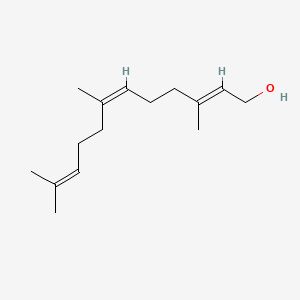| MeSH term | MeSH ID | Detail |
|---|---|---|
| Cell Transformation, Neoplastic | D002471 | 126 associated lipids |
| Thyroid Neoplasms | D013964 | 33 associated lipids |
| Carcinoma, Hepatocellular | D006528 | 140 associated lipids |
| Fibrosis | D005355 | 23 associated lipids |
| Leukemia, Myeloid, Acute | D015470 | 19 associated lipids |
| Hypergammaglobulinemia | D006942 | 9 associated lipids |
| Glioblastoma | D005909 | 27 associated lipids |
| Nephritis | D009393 | 19 associated lipids |
| HIV Infections | D015658 | 20 associated lipids |
| Neurilemmoma | D009442 | 10 associated lipids |
(e,z)-farnesol
(e,z)-farnesol is a lipid of Prenol Lipids (PR) class.
Cross Reference
There are no associated biomedical information in the current reference collection.
Current reference collection contains 3613 references associated with (e,z)-farnesol in LipidPedia. Due to lack of full text of references or no associated biomedical terms are recognized in our current text-mining method, we cannot extract any biomedical terms related to diseases, pathways, locations, functions, genes, lipids, and animal models from the associated reference collection.
Users can download the reference list at the bottom of this page and read the reference manually to find out biomedical information.
Here are additional resources we collected from PubChem and MeSH for (e,z)-farnesol
Possible diseases from mapped MeSH terms on references
We collected disease MeSH terms mapped to the references associated with (e,z)-farnesol
PubChem Biomolecular Interactions and Pathways
All references with (e,z)-farnesol
Download all related citations| Authors | Title | Published | Journal | PubMed Link |
|---|---|---|---|---|
| Yue W et al. | Mechanisms of acquired resistance to endocrine therapy in hormone-dependent breast cancer cells. | 2007 Aug-Sep | J. Steroid Biochem. Mol. Biol. | pmid:17616457 |
| Kuroda M et al. | Sesquiterpene farnesol inhibits recycling of the C55 lipid carrier of the murein monomer precursor contributing to increased susceptibility to beta-lactams in methicillin-resistant Staphylococcus aureus. | 2007 | J. Antimicrob. Chemother. | pmid:17242033 |
| Nokhodchi A et al. | The effect of terpene concentrations on the skin penetration of diclofenac sodium. | 2007 | Int J Pharm | pmid:17174049 |
| Cho T et al. | Transcriptional changes in Candida albicans Genes by both farnesol and high cell density at an early stage of morphogenesis in N-acetyl-D-glucosamine medium. | 2007 | Nihon Ishinkin Gakkai Zasshi | pmid:17975531 |
| Kuroda M et al. | Sesquiterpene farnesol as a competitive inhibitor of lipase activity of Staphylococcus aureus. | 2007 | FEMS Microbiol. Lett. | pmid:17559400 |
| Zundelevich A et al. | Suppression of lung cancer tumor growth in a nude mouse model by the Ras inhibitor salirasib (farnesylthiosalicylic acid). | 2007 | Mol. Cancer Ther. | pmid:17541036 |
| Navarathna DH et al. | Exogenous farnesol interferes with the normal progression of cytokine expression during candidiasis in a mouse model. | 2007 | Infect. Immun. | pmid:17517874 |
| Uppuluri P et al. | Farnesol-mediated inhibition of Candida albicans yeast growth and rescue by a diacylglycerol analogue. | 2007 | Yeast | pmid:17583896 |
| Crowell DN et al. | Arabidopsis thaliana plants possess a specific farnesylcysteine lyase that is involved in detoxification and recycling of farnesylcysteine. | 2007 | Plant J. | pmid:17425716 |
| Blum R et al. | Gene expression signature of human cancer cell lines treated with the ras inhibitor salirasib (S-farnesylthiosalicylic acid). | 2007 | Cancer Res. | pmid:17409441 |
| Rossignol T et al. | Transcriptional response of Candida parapsilosis following exposure to farnesol. | 2007 | Antimicrob. Agents Chemother. | pmid:17684006 |
| Cugini C et al. | Farnesol, a common sesquiterpene, inhibits PQS production in Pseudomonas aeruginosa. | 2007 | Mol. Microbiol. | pmid:17640272 |
| Shintre MS et al. | Evaluation of an alcohol-based surgical hand disinfectant containing a synergistic combination of farnesol and benzethonium chloride for immediate and persistent activity against resident hand flora of volunteers and with a novel in vitro pig skin model. | 2007 | Infect Control Hosp Epidemiol | pmid:17265401 |
| Zhang L and Hill RP | Hypoxia enhances metastatic efficiency in HT1080 fibrosarcoma cells by increasing cell survival in lungs, not cell adhesion and invasion. | 2007 | Cancer Res. | pmid:17699784 |
| Joo JH et al. | Farnesol-induced apoptosis in human lung carcinoma cells is coupled to the endoplasmic reticulum stress response. | 2007 | Cancer Res. | pmid:17699800 |
| Lee H et al. | Characterization of (E,E)-farnesol and its fatty acid esters from anal scent glands of nutria (Myocastor coypus) by gas chromatography-mass spectrometry and gas chromatography-infrared spectrometry. | 2007 | J Chromatogr A | pmid:17709112 |
| Marciano D et al. | Neuroprotective effects of the Ras inhibitor S-trans-trans-farnesylthiosalicylic acid, measured by diffusion-weighted imaging after traumatic brain injury in rats. | 2007 | J. Neurotrauma | pmid:17711399 |
| Cheng AX et al. | The rice (E)-beta-caryophyllene synthase (OsTPS3) accounts for the major inducible volatile sesquiterpenes. | 2007 | Phytochemistry | pmid:17524436 |
| Cetin A et al. | Angiotensin II-induced MAPK phosphorylation mediated by Ras and/or phospholipase C-dependent phosphorylations but not by protein kinase C phosphorylation in cultured rat vascular smooth muscle cells. | 2007 | Pharmacology | pmid:17135774 |
| Hasmim M et al. | Zoledronate inhibits endothelial cell adhesion, migration and survival through the suppression of multiple, prenylation-dependent signaling pathways. | 2007 | J. Thromb. Haemost. | pmid:17059425 |
